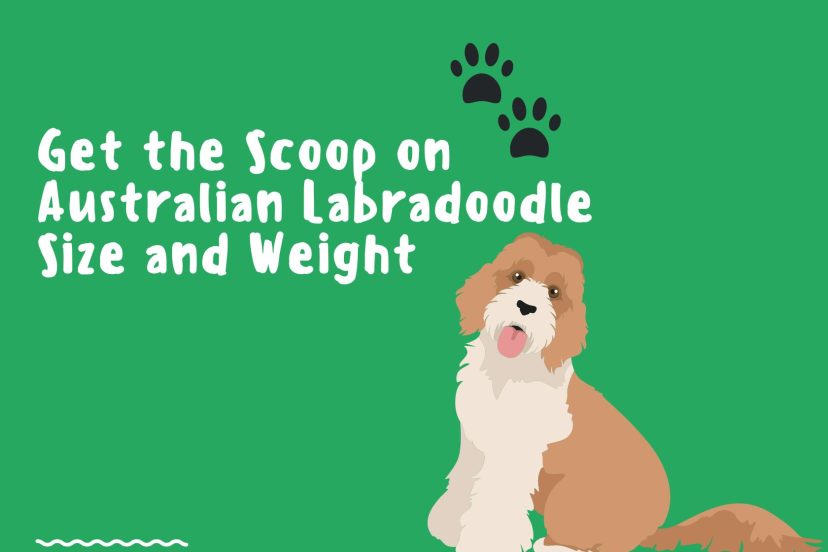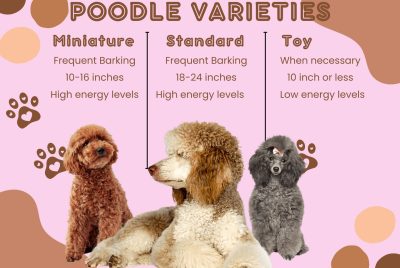Get the Scoop on Australian Labradoodle Size and Weight
Choosing the perfect Labradoodle for your family isn’t merely about falling in love with a pair of puppy eyes, it goes deeper into understanding what to expect as they blossom. The Labradoodle size and weight can intertwine tightly with your lifestyle, underlining why knowledge of their growth patterns is so pivotal.
This article sets out to unveil the mysteries behind the diverse sizes of Labradoodles—from petite miniatures to majestic standards—and equips you with a dependable growth chart, ensuring you’re not caught off guard as your furry companion matures.
Through my journey raising and training Labradoodles, I’ve learned that forecasting their adult size is an art form that extends beyond simple guesses about paw dimensions. Years committed to poring over breed standards and witnessing the evolution of these endearing canines from up close have enriched me with insights.
Factors like genetics and diet weave together in determining their ultimate stature. Are you ready for some clear-cut answers? Let’s dive in!
Key Takeaways
- Labradoodles come in three main sizes: miniature, medium, and standard. Miniatures are 10-15 inches tall and weigh 10-20 lbs; mediums stand at 17-20 inches with a weight of 30-45 lbs; while standards range from 21-24 inches in height and weigh between 50-65 lbs.
- The growth and final size of a Labradoodle depend on several factors including genetics, the gender of the dog, its diet, and how much exercise it gets. Genetics play a crucial role because they inherit traits from Poodle and Labrador parents which influence their eventual size.
- Using growth charts like “The Four Fold Formula” or “The Double Up Formula” can help predict the adult size of a Labradoodle puppy. These formulas take into account various factors such as current weight or genetic contributions from parent breeds to estimate future growth.
- A balanced diet and regular exercise are essential for maintaining a healthy weight in Labradoodles. This ensures they develop properly without facing obesity-related health issues or excessive strain on their joints due to inappropriate weight gain.
- Choosing the right – sized Labradoodle for your living situation enhances comfort for both you and your pet. Smaller dogs may be better suited for apartments while larger ones might need more space to roam freely. It also makes training easier since different sizes adapt differently to various living conditions and physical demands.
Understanding Labradoodle Sizes and Weights
Labradoodles come in various sizes, namely miniature, medium, and standard. Miniature Labradoodles typically measure 10-15 inches and weigh between 10-20 lbs. Medium Labradoodles are slightly larger at 17-20 inches and weigh between 30-45 lbs.
Standard Labradoodles are the largest, measuring 21-24 inches with a weight range of 50-65 lbs.
Miniature Labradoodles (10-15 inches, 10-20 lbs)
I find the charm of miniature Labradoodles irresistible, standing just 10-15 inches tall and weighing between 10-20 lbs. These pint-sized pups pack all the delightful qualities of their larger counterparts into a compact, easy-to-manage size.
They’re perfect for apartment living or for those with smaller spaces. Their size also makes them highly adaptable to various lifestyle needs, from being a cuddly lap dog to an energetic companion ready for adventure.
Choosing a miniature Labradoodle offers several advantages. It’s easier to carry them around and take on trips, making travel less stressful for both owner and pet. Training and daily exercise are more manageable due to their smaller size without compromising on the intelligence and affectionate nature inherent in the breed.
This version of the Australian Labradoodle size and weight fits perfectly into many families looking for a dog that has it all: personality, intelligence, and a manageable size.
Medium Labradoodles (17-20 inches, 30-45 lbs)
Transitioning from discussing miniature Labradoodles, medium-sized ones offer a bit more size and weight. Medium Labradoodles typically measure between 17-20 inches in height and weigh around 30-45 lbs.
As an owner of a medium Labradoodle, I have found that their size strikes an ideal balance – not too small to feel fragile, yet not too large to be overwhelming. This makes them perfect for families or individuals looking for a well-proportioned companion dog that is sturdy but still manageable.
These dogs are versatile and adaptable, fitting well into various living situations due to their moderate size. Their energy levels make them suitable for both indoor and outdoor activities while also being easier to handle during walks or playtime.
Standard Labradoodles (21-24 inches, 50-65 lbs)
As we transition from discussing medium Labradoodles to standard Labradoodle size and weight, it’s important to note that standard Labradoodles typically measure between 21-24 inches in height and weigh between 50-65 lbs.
They are known for their sturdy build and make wonderful companions for families or individuals seeking a larger yet still manageable dog. These dogs are often well-suited for various activities, including daily walks, playtime, and even advanced training exercises.
Standard Labradoodles (21-24 inches, 50-65 lbs) display an excellent balance of size and agility while maintaining an affectionate nature towards their owners. Their robust physique makes them adaptable to different living environments and fits in well with various lifestyles.
Labradoodle Growth and Weight Chart
The Labradoodle growth and weight chart provides a useful tool for tracking your dog’s development. It helps you ensure that they are growing at a healthy rate, setting the stage for their overall well-being.
The Four Fold Formula
As a Labradoodle owner, understanding their growth and size is important. “The Four Fold Formula” plays a crucial role in predicting the adult size of your Labradoodle puppy. This formula incorporates the genetic contribution from both parent breeds, as well as specific genes that determine size.
By using this formula, it becomes easier to estimate how large your Labradoodle will grow, helping you plan for their needs in terms of food, exercise, and living space.
Labradoodle owners can benefit from utilizing “The Four Fold Formula.” It provided me with valuable insights into what to expect as my Labradoodle pup grows up and helped me tailor its care based on its anticipated size.
Understanding this formula ensures that you are better prepared for the lifelong commitment of caring for your furry friend.
The Double Up Formula

Moving on from the Four Fold Formula, let’s delve into the Double Up Formula. It is a straightforward approach that involves doubling a Labradoodle’s weight at four months of age to predict its final adult weight.
For example, if your Labradoodle weighs 15 pounds at four months, you can reasonably expect it to reach around 30 pounds in adulthood. This formula provides a quick and easy way for owners to estimate their pup’s future size, aiding in planning for space requirements, feeding amounts, and overall care.
This simple yet effective method can help pet owners make informed decisions about their dog’s needs as they grow. By using the Double Up Formula alongside other growth indicators and considering genetics and gender factors, you can gain a clearer understanding of what lies ahead in terms of your Labradoodle’s size and weight.
Factors Affecting Labradoodle Size
Factors like genetics, gender, and diet significantly impact the size of Labradoodles. Genetics determine the potential growth outcome for each dog, while gender also plays a role in their ultimate size.
Diet and exercise habits influence how Labradoodles develop physically as they grow.
Genetics
Genetics plays a significant role in determining the size and weight of a Labradoodle. The traits inherited from the parent breeds, such as Poodles and Labrador Retrievers, influence the puppy’s eventual size.
Through selective breeding, breeders aim to achieve consistent size standards within different categories like miniature, medium, and standard Labradoodles. It is essential for potential owners to consider genetics when selecting a Labradoodle based on their desired size and weight preferences.
Factors impacting how genetics contribute to Labradoodle sizes include a combination of dominant and recessive genes from both parent breeds. Understanding the genetic makeup of a labradoodle can provide valuable insights into its potential growth trajectory as it matures.
Gender
In terms of labradoodle size and weight, gender plays a significant role. Male labradoodles tend to be larger and heavier than females, with males typically falling into the higher end of the weight and height ranges for each size category.
This difference is primarily due to biological factors and can influence your decision when choosing the right-sized labradoodle for your lifestyle.
When it comes to determining the ideal labradoodle size for you, it’s important to consider both male and female options before making a decision.
Diet and Exercise
As an owner, I have found that a well-balanced diet and regular exercise play pivotal roles in the healthy development of labradoodles. Providing high-quality dog food formulated for their size and activity level is essential.
Regular exercise such as daily walks, playtime, and mental stimulation not only keeps them physically fit but also promotes good behavior. It’s also important to monitor portion sizes and treats to prevent overfeeding.
A combination of nutritious meals and consistent physical activity contributes significantly to the overall well-being of these delightful companions.
Benefits of Choosing the Right Size Labradoodle
Choosing the right Labradoodle size and weight ensures comfort for both owner and dog. Read on to discover more about the benefits of selecting the perfect fit for your lifestyle and needs.
Comfort for both owner and dog
Choosing the right size labradoodle can provide both the owner and dog with a comfortable living situation. It ensures that the dog fits well within the home environment, creating a harmonious atmosphere.
Additionally, it allows for easier management during walks or outings as well as providing adequate space for the dog to move around freely in their living space.
The proper-sized labradoodle also benefits its overall health by preventing strain on joints and muscles caused by being too small or carrying excess weight. This not only enhances the dog’s physical comfort but also reduces potential health issues associated with an improper size.
Easier to manage and train
Choosing the right size Labradoodle can make it easier to manage and train. A smaller dog is often more manageable, especially in smaller living spaces or for those with physical limitations.
With proper training, a well-exercised and mentally stimulated small Labradoodle can be just as well-behaved as their larger counterparts. Additionally, their size allows them to be easily handled during grooming and vet visits, providing a smoother experience for both owner and pet.
As a proud owner of a miniature Labradoodle myself, I have experienced firsthand how their size makes them easier to manage and train. Their compact stature has made it simpler to teach obedience commands and leash walking.
Reduces potential health issues
Transitioning from managing and training your Labradoodle to considering their potential health, choosing the right size can reduce potential health issues. By selecting a Labradoodle that is an appropriate size for your living space and lifestyle, you can help prevent joint problems, obesity-related issues, and cardiovascular strain in your furry companion.
It’s vital to consider the long-term impact of size on their overall well-being.
Consistent exercise and a balanced diet are essential components of maintaining a healthy weight for your Labradoodle. It’s important to monitor their growth according to the recommended guidelines so as not to overfeed them or push them beyond their physical limits during exercise.
Frequently Asked Questions
How big do Labradoodles get?
Labradoodles grow to different sizes based on their type, with Australian Labradoodle sizes ranging from miniature to standard. The size and weight can vary, but they generally fit into three categories: mini, medium, and standard.
What is the average weight of a Labradoodle?
The average weight of a Labradoodle depends on its size category. Miniature ones weigh less compared to medium or standard Labradoodles. Male and female Labradoodles also might have slight differences in weights and heights.
Can I predict how big my Labradoodle puppy will get?
Yes, you can use a Labradoodle growth chart or a puppy weight calculator to estimate your dog’s adult size. Factors like nutrition and genetics play a role in determining the final size.
Are Australian Labradoodles smaller than other types?
Australian Labradoodles come in various sizes including miniature, which are often smaller than the standard-sized ones found in other variations of the breed.
Do all Labradoodles grow at the same rate?
No, their growth rates can differ significantly depending on their ultimate size – miniatures mature faster than standards for instance – as well as individual factors like diet and health conditions affecting overall labrador doodle growth stages.
Conclusion
Understanding Labradoodle sizes and weights is crucial for choosing the right pet. Miniature, medium, and standard Labradoodles vary in height and weight. The Labradoodle growth chart enables accurate prediction based on age and size category.
Genetics, gender, diet, and exercise influence Labradoodle size. Choosing the right-sized Labradoodle ensures comfort for both owner and dog while reducing potential health issues.
Implementing these strategies can make a significant impact on your experience as a labradoodle owner.




